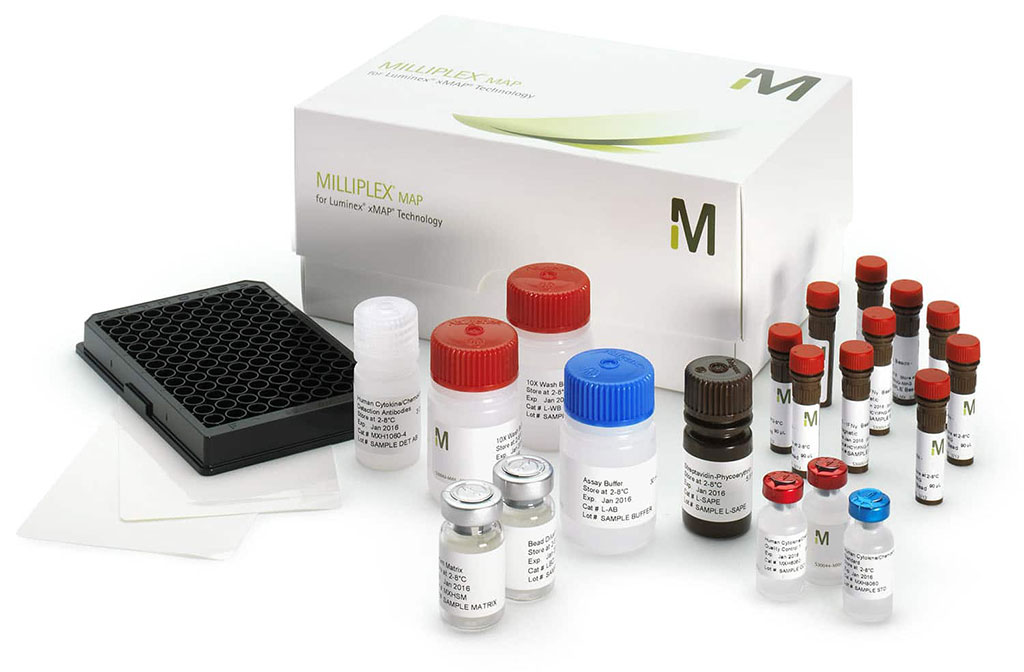Diagnostic Efficacy of Immunomarkers in Fungal Bloodstream Infection
By LabMedica International staff writers
Posted on 05 Feb 2020
Fungemia is the presence of fungi or yeasts in the blood and is a life‐threatening condition with the global mortality rate surging more than fivefold in the past decade. It has been reported that the outcome depends on early and targeted treatment; thus, prompt diagnosis is essential at the early stage of infection.Posted on 05 Feb 2020
Currently, early diagnosis of fungemia remains a complicated issue. Although blood culture remains the reference method for the detection of fungemia, this method takes 3‐5 days to generate positive results and also suffers from low sensitivity, which could not meet the requirement of early diagnosis and clinical guidance for fungemia.

Image: The MILLIPLEX MAP Human Cytokine/Chemokine Magnetic Bead Panel - Premixed 30 Plex - Immunology Multiplex Assay (Photo courtesy of Merck).
Clinical Laboratory scientists at the Chinese PLA General Hospital (Beijing, China) included in their study 41 patients with fungemia who were compared with 57 patients with negative blood culture results. Blood samples for culture were taken from the patients for two to three times and inoculated using BACTEC PLUS Aerobic/F (Becton, Dickinson and Company, Franklin Lakes, NJ, USA) blood culture bottles. The isolations from blood culture were identified to species with VETIK YBC card (bioMérieux, Marcy-l'Étoile, France) and bioMérieux MALDI‐TOF‐MS.
The serum samples were analyzed using the xMAP Bead Array Platform (Luminex Corporation, Austin, TX, USA). A combination of 14 cytokines and chemokines was quantified using the reagents of selected ones from Human Cytokine 30‐Plex Panel Kit (Merck-Millipore, Burlington, MA, USA). Evaluated cytokines included the following: IL‐1β, ‐2, ‐3, ‐4, ‐6, ‐8, 10, 17, 12p70, INF‐γ, TNF‐α, G‐CSF, RANTES, and MIP‐1β. C-reactive protein (CRP) was measured using nephelometric method (Siemens BNII, Cardiophase, Erlangen, Germany), and procalcitonin (PCT) was measured by cobas 800 (Roche, Basel Switzerland) based on electrochemical luminescence technology.
The scientists reported that C‐reactive protein and procalcitonin were significantly higher compared with those in negative control group, while white blood cell, percentage of neutrophil, percentage of lymphocyte, and ratio of neutrophil and lymphocyte did not differentiate between two groups. Serum levels of IFN‐γ, TNF‐α, MIP‐1β, IL‐6, IL‐8, IL‐10, IL‐12p70, and IL‐17 were significantly higher in patients with fungemia compared with the control group. Combination of MIP‐1β and IL‐17 could improve the AUC, sensitivity, and specificity for the diagnosis of fungemia.
The authors concluded that they had found eight serum cytokines/chemokines that significantly increased in the fungemia group when compared with the culture‐negative control group. Among them, MIP‐1β and IL‐17 might be given more attention during the diagnosis of fungemia. The study was published on January 23, 2020 in the Journal of Clinical Laboratory Analysis.
Related Links:
Chinese PLA General Hospital
Becton, Dickinson and Company
Merck-Millipore
bioMérieux
Luminex Corporation
Siemens
Roche













